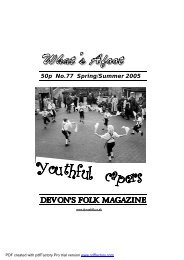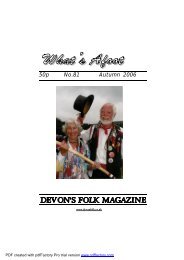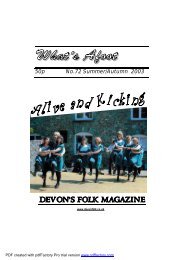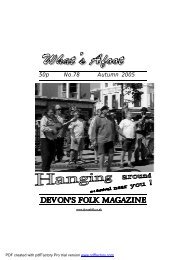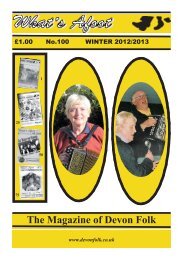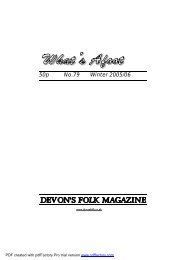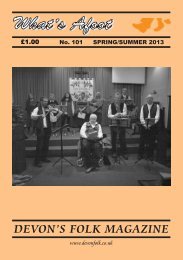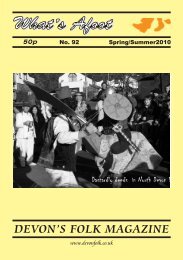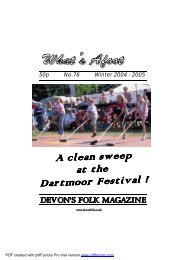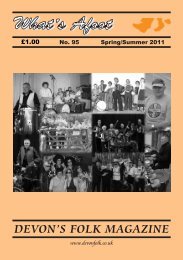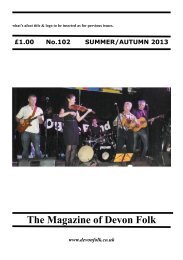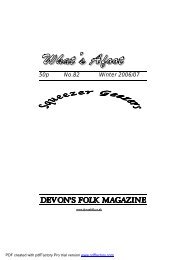You also want an ePaper? Increase the reach of your titles
YUMPU automatically turns print PDFs into web optimized ePapers that Google loves.
My Grandfather had one of those<br />
A guide to those old squeezeboxes found in the<br />
attic and for people considering purchasing one<br />
for the rst time.<br />
I’ve heard this – or something similar, like<br />
an uncle – on a number of occasions from a<br />
member of the audience when I’ve been playing<br />
a squeezebox for dancing or in a pub session. It’s<br />
still not unusual to nd a family who have an old<br />
squeezebox languishing unplayed in their attic,<br />
unaware of its musical characteristics or potential<br />
value. Some of them nd their way into junk<br />
shops from house clearances and some appear on<br />
Ebay, where a quality instrument will usually be<br />
recognised despite an uncertain description .<br />
Most people would probably recognise a piano<br />
accordion from its keyboard layout on the right<br />
hand but if the squeezebox is all buttons then it<br />
may be described by anyone unfamiliar with<br />
the instruments as an accordion, melodeon or<br />
concertina regardless of its true identity. This<br />
article will, I hope, aid recognition.<br />
If the squeezebox is small with hexagonal or, less<br />
commonly, octagonal ends then you are looking<br />
at a concertina. These particular instruments have<br />
become particularly popular in recent years, and a<br />
good quality model even in need of some attention<br />
can command a four gure price at auction. But<br />
you need to know what you’re looking at, in<br />
order to assess its value if you are selling, and<br />
its suitability for your purpose if you’re in the<br />
market for buying one for the rst time, for there<br />
are three very different types of concertina – the<br />
Anglo, the English, and the Duet.<br />
The Anglo will usually have two or three rows<br />
of buttons on each side, and buttons will give<br />
a different note depending on whether you push<br />
or pull on the bellows with the button depressed.<br />
These instruments are set in two denite keys,<br />
C/G, or G/D being the most common, but other<br />
combinations (such as Bb, F) are not unusual.<br />
The two row models are denitely not fully<br />
chromatic, and while the three row models may<br />
have all the other notes not in the major scale of<br />
the two given keys, it is much more difcult to<br />
play in another key. To determine the keys of the<br />
instrument, on the right hand side (there’s a small<br />
4<br />
air button on its own near the thumb) push the<br />
rst button (nearest index nger) of the rst row<br />
(nearest one’s palm), and match it to a known note<br />
on a pitch pipe, piano. or other instrument. Repeat<br />
with the rst button of the 2nd (or middle row, if<br />
3 rows). Older instruments may not be in concert<br />
pitch, especially if they have lain idle for several<br />
years, but one should be able to get a pretty good<br />
approximation. The scale, for the most part, is<br />
obtained by working along the row, pushing<br />
and pulling with each button in turn, much like<br />
blowing and sucking on a mouth organ.<br />
A basic Anglo can be purchased very reasonably<br />
for around £100, but don’t expect much in the<br />
way of quality. Generally the more garish the<br />
colour, the poorer the quality. Paradoxically, the<br />
best quality Anglos fetch the highest prices on<br />
Ebay - £4000 plus is not unheard of.<br />
Like the Anglo, the straps on a duet concertina rest<br />
on the back of the hand, allowing all four ngers<br />
to access the buttons. Duet concertinas, however,<br />
are fully chromatic, and play the same note on<br />
push and pull, with bass notes on the left side and<br />
treble notes played by the right hand. This allows<br />
chords or counter-melody to be played easily with<br />
the tune. To add to the confusion, there’s more<br />
than one kind of arrangement of the notes, but the<br />
most common are the McCann system and the<br />
Crane system. Both have the ‘black’ notes – the<br />
sharps and ats – on the two outside columns (the<br />
lines of buttons going from palm to ngertip), and<br />
the ‘white’ notes in four columns in the McCann,<br />
and three columns in the Crane (a far more logical<br />
system, in my opinion). Cranes tend to be more<br />
harder to come by on the second-hand market,<br />
and thus are likely to be more expensive; think<br />
four gures instead of three for a Crane, although<br />
the make and model naturally affects the cost.<br />
English concertinas have four columns of buttons,<br />
again with the sharps and ats on the outside.<br />
Usually there is no broad strap for the hand,<br />
however, but on each side a thumb strap and a<br />
small metal plate on which the little nger rests.<br />
The notes are the same on push and pull, and a<br />
scale is obtained by playing alternately right<br />
hand and left hand. Limited range instruments



